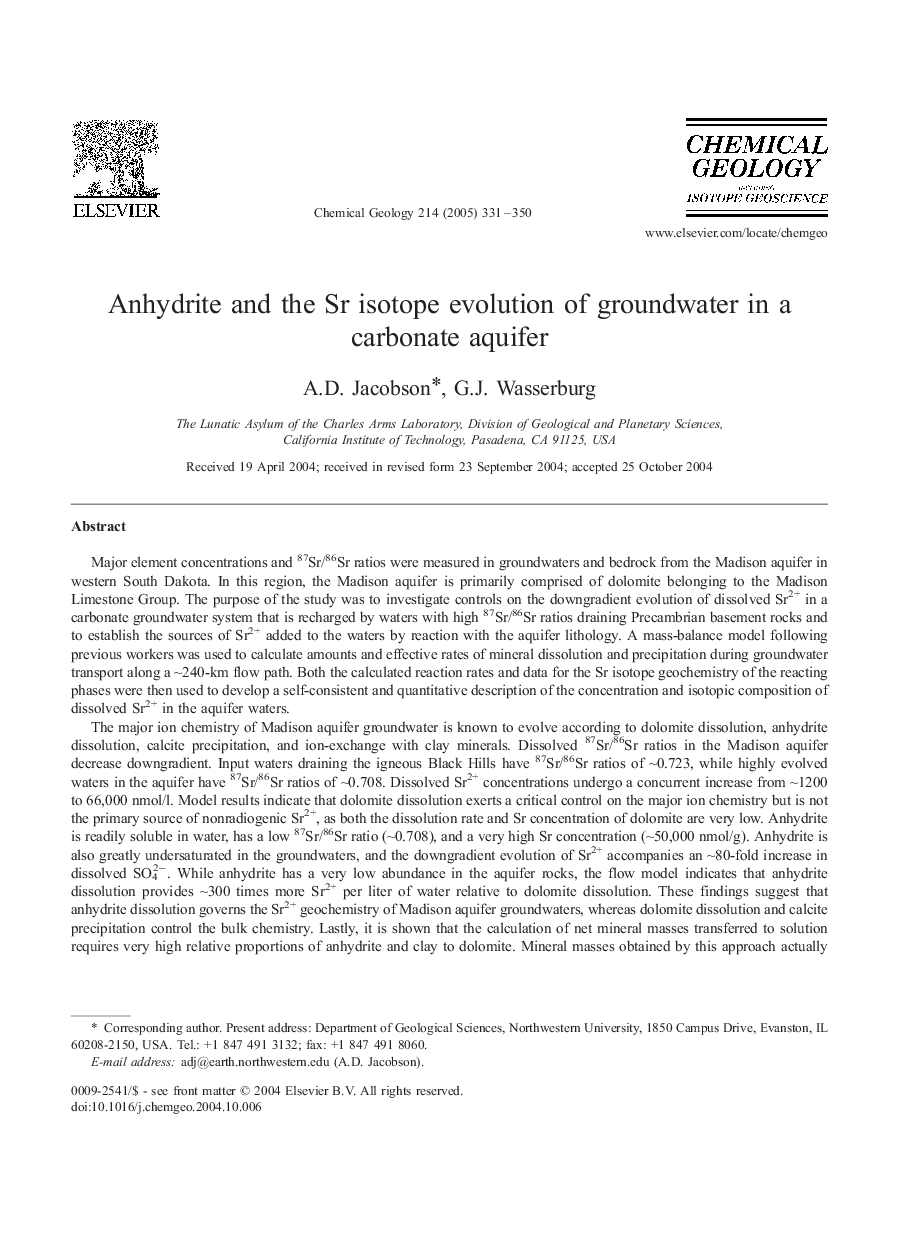| کد مقاله | کد نشریه | سال انتشار | مقاله انگلیسی | نسخه تمام متن |
|---|---|---|---|---|
| 9529239 | 1637794 | 2005 | 20 صفحه PDF | دانلود رایگان |
عنوان انگلیسی مقاله ISI
Anhydrite and the Sr isotope evolution of groundwater in a carbonate aquifer
دانلود مقاله + سفارش ترجمه
دانلود مقاله ISI انگلیسی
رایگان برای ایرانیان
کلمات کلیدی
موضوعات مرتبط
مهندسی و علوم پایه
علوم زمین و سیارات
ژئوشیمی و پترولوژی
پیش نمایش صفحه اول مقاله

چکیده انگلیسی
The major ion chemistry of Madison aquifer groundwater is known to evolve according to dolomite dissolution, anhydrite dissolution, calcite precipitation, and ion-exchange with clay minerals. Dissolved 87Sr/86Sr ratios in the Madison aquifer decrease downgradient. Input waters draining the igneous Black Hills have 87Sr/86Sr ratios of â¼0.723, while highly evolved waters in the aquifer have 87Sr/86Sr ratios of â¼0.708. Dissolved Sr2+ concentrations undergo a concurrent increase from â¼1200 to 66,000 nmol/l. Model results indicate that dolomite dissolution exerts a critical control on the major ion chemistry but is not the primary source of nonradiogenic Sr2+, as both the dissolution rate and Sr concentration of dolomite are very low. Anhydrite is readily soluble in water, has a low 87Sr/86Sr ratio (â¼0.708), and a very high Sr concentration (â¼50,000 nmol/g). Anhydrite is also greatly undersaturated in the groundwaters, and the downgradient evolution of Sr2+ accompanies an â¼80-fold increase in dissolved SO42â. While anhydrite has a very low abundance in the aquifer rocks, the flow model indicates that anhydrite dissolution provides â¼300 times more Sr2+ per liter of water relative to dolomite dissolution. These findings suggest that anhydrite dissolution governs the Sr2+ geochemistry of Madison aquifer groundwaters, whereas dolomite dissolution and calcite precipitation control the bulk chemistry. Lastly, it is shown that the calculation of net mineral masses transferred to solution requires very high relative proportions of anhydrite and clay to dolomite. Mineral masses obtained by this approach actually represent bulk contributions without consideration of the intrinsic reaction rates of the phases or their modal abundances in the aquifer rocks. However, consideration of these parameters in a transport equation for flow through porous media shows that the high apparent abundances are not a real requirement. This latter approach is consistent with laboratory experiments and indicates that as little as 0.04 wt.% of very soluble anhydrite and 0.3 wt.% of exchangeable clay in the aquifer rock are sufficient to produce the observed groundwater chemistry in most of the flow path.
ناشر
Database: Elsevier - ScienceDirect (ساینس دایرکت)
Journal: Chemical Geology - Volume 214, Issues 3â4, 25 January 2005, Pages 331-350
Journal: Chemical Geology - Volume 214, Issues 3â4, 25 January 2005, Pages 331-350
نویسندگان
A.D. Jacobson, G.J. Wasserburg,